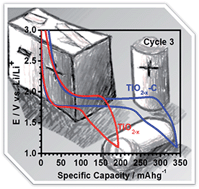Oxygen deficient, carbon coated self-organized TiO2 nanotubes as anode material for Li-ion intercalation†
Abstract
Since several years, research for high capacity anode materials in Li-ion batteries is addressed to titanium dioxide (TiO2), which offers important advantages in terms of cost effectiveness, safety and environmental compatibility. This work reports on the lithiation and delithiation characteristics of anodically grown, self-organized TiO2 nanotubes annealed in Ar (TiO2−x) and Ar/C2H2 (TiO2−x–C). The systems are used as model composite electrodes for the anode in Li-ion batteries. Anatase TiO2−x–C nanotubes demonstrate a superior Li storage capacity as high as 320(±68) mA h g−1 (Li0.96TiO2) compared to 180(±38) mA h g−1 (Li0.54TiO2) for TiO2−x. This is comparable to the highest reported capacities for TiO2 nanotubes to date. The double layer capacities are estimated from cyclic voltammetry measurements to 85 μF cm−² for TiO2−x and 20 μF cm−² for TiO2−x–C nanotubes respectively. Additionally, electrochemical impedance spectroscopy reveals smaller charge transfer resistances for TiO2−x–C nanotubes at the solid/liquid interface which improves the transfer of Li+-ions from the electrolyte into the electrode.

- This article is part of the themed collection: 2015 Journal of Materials Chemistry A Hot Papers

 Please wait while we load your content...
Please wait while we load your content...